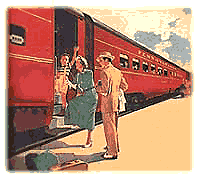It was a good article overall but, in my view, had a few flaws. Wilson writes that the interstate system brought "unpleasant and unintended consequences. ... Among those were the deterioration of the railroads, which lost passenger and freight traffic to the highways, and the erosion of public transit systems."
Let's start with public transportation. In the beginning of the 20th Century, ridership grew steadily until the Great Depression. Between 1929 and 1939, people took fewer work trips and often could not afford to take leisure trips. World War II fuel rationing forced many to use public transport. Patronage peaked in 1946, when Americans took 23.4 billion trips on trains, buses and trolleys.
After the war, cheap, plentiful fuel and general prosperity caused a surge in car ownership. By 1960, ridership dropped to 9.3 billion trips - even though there were few interstate highways at that point.
Most privately-owned transit companies disappeared in the 1940-50 period - the business was no longer profitable. Ownership was soon transferred to public entities (cities and/or states). Public transit was on life support before there were interstates.
 Then there's the issue of trains - the heyday of rail passenger service in America was in the 1920s. In those times, railroads were profitable and passengers were happy.
Then there's the issue of trains - the heyday of rail passenger service in America was in the 1920s. In those times, railroads were profitable and passengers were happy.
During the depression of the Thirties, the railroads struggled to stay alive. In the early 1930s, rail passenger ridership declined by 41% as a direct result of the economic depression. In the early Forties, the railroads made money on passenger service only because of massive troop movements caused by World War II. But by then, many trains were overtaxed and worn out and people were stuffed in them like sardines.
After the war, passenger business on the railroads dried up. People drove to their destinations. Or flew. By the mid-1950s (prior to the establishment of the Interstate Highway System), train travel was a mere shadow of its former self. The Pennsylvania Railroad's experience was typical. Like the rest of the nation's railroads, the Pennsy had not earned a profit from passenger service since 1946, despite multi-million dollar postwar investments in passenger equipment and facilities. Competition from the use of automobiles for medium-distance intercity trips prevented the railroads from increasing fares enough to cover soaring labor and material costs.
Rail freight service was in decline long before the interstate. LCL (less-than-carload) shipments by rail peaked at 50 million tons in 1919; by 1958, it had declined to 4 million tons. Trucks were faster and more cost-effective for trips of two days or less, especially for LCL shipments. The interstate just made things even worse for rail freight - and easier for truckers.
The Interstate Highway System has also been blamed for the "cultural homogenization" and "deterioration of regional distinction". I would submit that much of the increase in cultural uniformity is due to the advent of coast-to-coast television shows.
As someone who traveled much in the pre-interstate days, I can state authoritatively that most of those "lost" regional distinctions weren't worth keeping anyway - run-down wooden vegetable stands, alligator farms, seedy drive-ins, lame kiddie zoos, bedbug-infested motels, speed traps and thirty-seven million tasteless billboards. Getting there was never half the fun.
Elvis Presley was born before I was and was exposed to the Interstate Highway System relatively late in his life. He bought Graceland in 1957 - before there was a single interstate in Tennessee. Viewing the decor at Elvis' home, a visitor once remarked that the place "seemed to be furnished entirely with dreck from roadside stands." That's what makes Graceland unique. And, thanks to interstate highways, you'd have a difficult time duplicating it today. Good thing, too.
Speaking of roadside stands, what was the deal with the ones selling pottery? Now, I don't know about you, but I generally travel with a pretty full trunk. So ... when I think souvenirs, the last thing on my mind is a gigantic fired pot. I'm generally thinking of something smaller and less fragile - like a plastic refrigerator magnet in the shape of a cactus. Or something similar. And I've never been to someone's home where they're showing off something large and heavy in glazed clay and bragging, "We picked it up while on vacation."
In conclusion ... God bless the Interstate. But, if you're still looking for off-the-beaten path routes to anywhere, they remain available for your enjoyment. Freedom of choice continues to be an American tradition. (posted 7/14/06)

